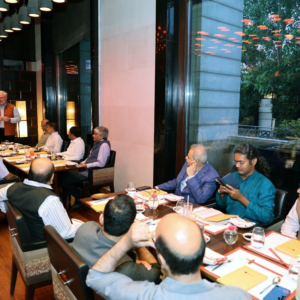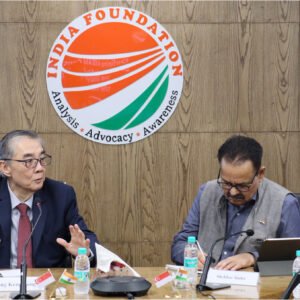Origins of Hijab in Islam
The practice of veiling predates Islam in the Arabic peninsula. “Khimar” as it is referred to is a head scarf that was practised by both men and women in the pre-Islamic world, which basically is a scarf that is worn to cover the head and extends below on the back of a person. Depending on the length of the “Khimar”, several words in Arabic exist to describe the garment worn by a person. Reference to the Khimar can also be found in verse Surah al-Nur 24:31[1] of the Quran, which basically prescribes women to use the “Khimar” and use it to cover the chest. Hence, this semantic difference has to be understood in order to understand the debate about Hijab/Burqa being an essential practice in Islam.[2] The other Surah in the Quran that discusses cloaking women in Islam is the Surah-al-Ahzab 33:59, which mandates the following,
“O Prophet! Tell your wives and your daughters and the women of the believers to draw their cloaks (veils) all over their bodies (i.e. screen themselves completely except the eyes or one eye to see the way). That will be better, that they should be known so as not to be annoyed. And Allah is Ever Oft-Forgiving, Most Merciful.”
Essential Religious Practice vs Fundamental Rights in India
While arguments including a Karnataka High Court judgement in the Resham v. State of Karnataka and Others (2022) claim “Hijab as a non-essential part of Islam”[3],[4], it is necessary to understand the fact that the word “Hijab” in its form cannot be found in the Quran. As discussed previously, the word is “Khimar”. It is hence clear from these verses that an objective analysis of veiling or cloaking in Islam can be viewed as “essential practice”. Although this expression “essential practice”, purely from the academic point of view is based on references to the Quran and other religious scriptures of Islam, it has no legal basis. In India, the essentiality test is defined as, “Test to determine whether a part or practice is essential to the religion – to find out whether the nature of religion will be changed without that part or practise”, as per the Commissioner of Police v. Acharya Jagdishwaranand Avadhuta (2004) judgement[5] of the Honourable Supreme Court. An in-depth discussion on establishing Hijab as an essential practice in Islam and its practice as a fundamental right can be found in Shashwata Sahu’s article.[6] Although the premise of the argument is centred on individual rights, fundamental rights as well as education of Muslim women, it is clear from Article 25 and Article 19(2) that restrictions on fundamental rights too can be imposed in order to maintain public order, morality and health. Hence, the argument of Hijab as an essential practices from the perspective of restriction on fundamental rights, does not stand on firm ground. Additionally, the Karnataka High Court judgement as referred earlier, also cites examples of how practitioners of Islam, do not always wear the Hijab in public life, therefore, deeming it not as an essential practice.
Hijab in the Global Context
So, what exactly is Hijab and how does one have to reconcile the practice of veiling and contextualise it in contemporary Indian society? The term Hijab itself in Arabic means “barrier” or “partition”, and is applicable to both men and women in Islam. It however, overtime assumed patriarchal connotation and has resulted in its imposition only on veiling women. While, most societies across the world contain one form of patriarchy or the other, Hijab however is viewed as one of the most regressive of patriarchal impositions on women. It is interesting to note that the discussion on “Hijab as an essential practice” in India is contemporaneous with protests against “Hijab” and oppression of women in Islamist regimes like Iran. It is also important to note that even a country like Kingdom of Saudi Arabia is witnessing a slow but steady move towards liberalism and women’s rights under Mohammad bin Salman. Mohammad bin Salman himself, much to the chagrin of conservative elements of the Saudi society, has made it clear that the practice of Abaya or Hijab is not mandated by Islam and the country is currently undergoing a wave of progressivism.[7] It is therefore ironical that India is witnessing unending debates on the practice of Hijab, when the country where Islam originated is moving away from regressive patriarchal impositions.
Muslim Women’s Rights are a part of Women’s Rights
While political debates on issues like Hijab in India muddy the waters of women’s progress, it is essential to have a nuanced view on the discussion. Taking political sides in order to shape narratives is detrimental to Muslim women’s rights and reinforces control over them by the religious clergy. The time is ripe in India to initiate serious debates and discussions on the implementation of uniform civil laws in India, which on paper remains secular, yet courts intervene in matters of religious importance such as in the case of the Sabarimala verdict, Ayodhya verdict and even the Triple Talaq abolition. In a sense, Indian courts have assumed the status of religious authority, while the constitution of India declares the country as a secular state. Muslim women in India have been at the receiving end of “protecting secularism” for long, especially if one witnesses the reversal of Supreme court judgements such as in the Shah Bano case of 1986. While freedom of religion is guaranteed by India’s Constitution in Articles 25-28, it is also necessary that religious elements and practices that are deemed unsuitable for the current day be identified and restricted, for the country to progress ahead. It is vital to recognise today, that the onus of upholding freedom of religion should not rest on the shoulders of Muslim women or should not be viewed from the point of view of minority rights. Issues that are faced by Muslim women should only be viewed from the prism of women’s rights. This fundamental change in our judicial processes and public debates has to be emphatically established in order to move beyond religious debates.
Political Agendas as an Impediment to Muslim Women’s Rights
One can argue that there are concerted efforts going on globally and in sections of Indian intellectual class to portray India as undemocratic or being oppressive to minorities. Such efforts are primarily carried out to tarnish the current political dispensation and can effectively be countered by appropriate counter-narratives. Agenda driven and motivated movements should not become an impediment for the progress of Muslim women in India. What such movements essentially do in a country like India are the following:
- Encourage regressive Islamist elements to hijack the debate
- Keep Muslim women oppressed under patriarchal practices
- Prevent Muslim women from achieving their potential
With close to 200 million followers of Islam in India and with half of them being women, the progress of Muslim women in India is integral to the nation’s progress. As the world’s fifth largest economy and soon to become the world’s largest country by population, India is on the cusp of an era of tremendous transformation. It is in this context that Muslim women be equipped with necessary skills, vocational training and education, for them to join the mainstream of the society and contribute in a major way towards India’s economic progress. With women’s progress comes reform within the society, and in India’s Muslims, reform is long overdue. Several issues related to radicalisation, ghettoisation and discrimination against “non-believers”, can be achieved with the emancipation of Muslim women. While, women in India’s other religious denominations have achieved tremendous progress and contribute in a major way to national progress, Muslim women in India are being denied such opportunities and worse, are being subjected to debates on issues like Hijab. This only encourages regressive elements to dictate terms and conditions on the behaviour of Muslim women and hence such elements must be denied that opportunity to do so.
Uniform Civil Laws and Oppressive Elements in Islam
Today, every India is aware of how medieval mindsets have resulted in the complete annihilation of minority rights in Islamist nations like Pakistan. The country is a failed state and has totally marginalised any liberal voice that is critical of elements that have hindered the country’s progress. From abduction and forced conversions of underage girls to intolerance against Hindus, Pakistan is a basket case of religious extremism and its impact on Muslim women’s progress. Similarly, in Afghanistan, women are today accorded second class status with severe restrictions on their rights. In the case of Iraq and Syria, the emergence of ISIS has led to women of Yazidi and Kurdish heritage being viewed merely as sex-slaves and objects for gratification of men’s desires. Europe, thanks to the influx of immigrants from countries like Libya, Syria, Morocco, Tunisia etc, has become unsafe for women, with countries like Sweden figuring among countries with most number of rape cases. Mass molestations and underage girls being groomed for sexual favours are being witnessed from countries ranging from Greece to Germany and from France to the UK. “Sharia no go zones” where even law enforcement agencies cannot effectively enforce law have mushroomed across countries like Belgium, Netherlands, Norway etc.
In such a scenario, the only way to ensure Muslim women are safe is by bringing in civil laws that bring them on equal footing with women from other religious backgrounds in India. Uniform civil laws in India are a major step in the direction of gender equality in India, especially in terms of inheritance and maintenance. Medieval practices like Nikah, Halala and Polygamy are still common in India and Muslim women have for long been victims of such practices. Muslim women often find themselves at crossroads as large sections are kept so oppressed and away from any education that they are even unaware of laws and legality. In such a scenario, discussion around uniform civil laws will make Muslim women of India aware of what their future course of action should be in order to achieve equity with their counterparts from other religious denominations.
Conclusion
There is a need to bring forth discussions related to uniform civil laws in India in an effort to narrow the gap between rights enjoyed by non-Islamic women and Muslim women. Discussions raking up religious sentiments and efforts to divert the discussion away from Muslim women achieving the optimal potential or to keep them oppressed under oppressive patriarchal practices are detrimental to the larger national cause towards progress and development. The onus of secularism by imposing norms like Hijab and Niqab should not lie on the shoulders of Muslim women in India. Muslim women’s rights should purely be viewed from the point of view of women’s progress without political or religious agendas that are the motivation behind the scenes. Finally, the only way for Muslims of India to join the mainstream and contribute in a major way to the nation’s progress is by emancipating the Muslim women, who as professionals equipped with skills to survive in the 21st century, are likely to usher in the much-needed reform.
Author Brief Bio: Zeba Zoariah is a final year LL.B student at O.P Jindal Global University and is a Bachelors in Global Affairs from the same university. She writes articles on women’s rights, technology and law.
References:
[1] http://quransmessage.com/articles/a%20deeper%20look%20at%20the%20word%20khimar%20FM3.htm
[2] LANE. E.W, Edward Lanes Lexicon, Williams and Norgate 1863; Librairie du Liban Beirut-Lebanon 1968, Volume 2, Page 807-808
[3] https://theprint.in/judiciary/hijab-not-integral-to-islam-says-karnataka-high-court/873548/
[4] https://www.livelaw.in/pdf_upload/75-resham-v-state-of-karnataka-15-mar-2022-412165.pdf
[5] https://main.sci.gov.in/jonew/judis/25984.pdf
[6]https://www.ijllr.com/post/the-hijab-row-a-case-study-of-karnataka




